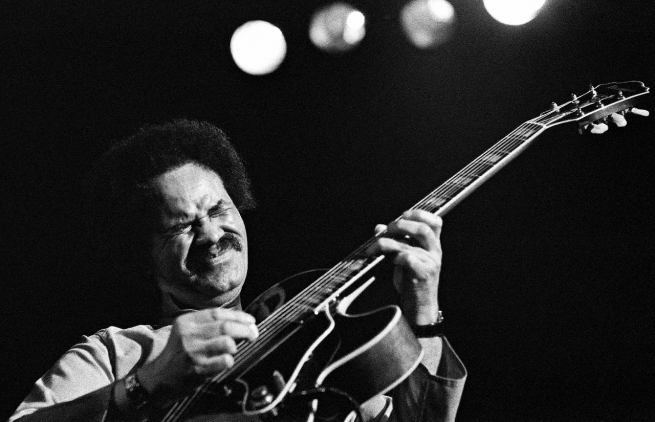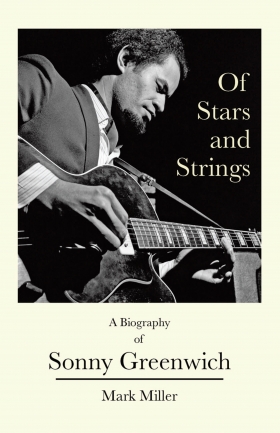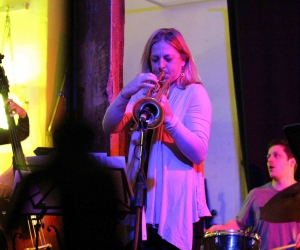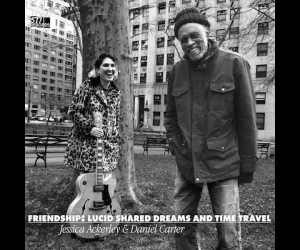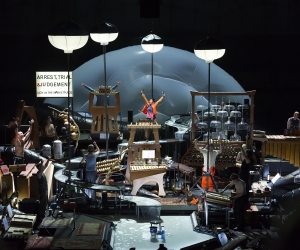In 1945 World War II was over and Herb Greenidge had just returned from his stint overseas, bringing with him a guitar that fascinated his third child. But rather than emulate dad—an accomplished pianist but a mediocre plectrist at best—Herbert Junior pursued a more idiosyncratic path. “His initial response to the presence of a guitar in the house was not to play it, but to play with it, as if it were a toy, rolling marbles along the ‘tracks’ created by its strings,” writes jazz historian Mark Miller in Of Stars and Strings, his new biography of the man who, with a slight change of name, would grow up to be guitar innovator Sonny Greenwich.
There is an entire school of guitar manipulators whose approach involves the application of sundry foreign objects to the strings—marbles, yes, but also violin bows, handheld fans, metal rods, electric razors, music boxes, and so on—but Greenwich was never one of them. Indeed, apart from some brief excursions on guitar synthesizer, he concentrated almost exclusively on the rudiments of the jazz guitarist’s arsenal: an instrument, an amplifier, and a pick. But Miller sees a connection between that initial playful encounter and Greenwich’s mature style, one of the most distinctive in jazz. “To wit,” he writes, “he related at first to the instrument visually, rather than musically, as he would in the early 1960s when he made the conceptual breakthrough that came, in his mind, to determine his style.”
Greenwich’s discovery was that by applying abstract patterns to the guitar’s fingerboard—patterns largely inspired by the early twentieth-century modernist painter and mystic Paul Klee’s characteristic shapes—he could break out of conventional harmony. “The pattern can change, or I can play the pattern up or down depending on the chords that are passing as I’m soloing,” he explained in a 2018 email to Miller. “I can leave the pattern and play melodically if I choose, or insert the pattern into the passing chords of the tune, which is what I do.”
The implications, audible in all of Greenwich’s recordings, have gone largely unsung in the wider world; what Miller is trying to accomplish with Of Stars and Strings is to tell that world that Canada, in the 1960s and afterwards, was home to a jazz innovator as daring as his contemporaries Eric Dolphy, Ornette Coleman, Miles Davis, and Wayne Shorter. That’s a claim backed up by Davis and Shorter, at least, who played briefly with Greenwich and were impressed by his adventurousness, emotional depth, and sound, which hovered on the edge of distortion well before fusion players brought that timbre into the jazz mainstream.
Miller, in his quiet and methodical way, accomplishes his task. Of Strings and Stars is refreshingly non-hagiographic, even as it establishes Greenwich’s credentials, tracks his influence on younger musicians, and celebrates the highlights of his small but impressive discography. The book is also, at times, a chronicle of frustrations and failures—if not on the personal level, at least in terms of the business of jazz. A freak accident in his youth left Greenwich subject to unpredictable seizures and fits; apparently triggered by air travel, these confined his career to North America and limited his willingness to tour even on this continent. What could have been a breakthrough Blue Note recording session with saxophonist Hank Mobley, 1967’s Third Season, was shelved, for reasons unknown, until 1980. And rumoured job offers from both Davis and Shorter were never consummated; the great trumpeter hired John McLaughlin instead, changing the course of jazz-guitar history, while the enigmatic saxophonist found pop-star levels of fame with Weather Report.
And yet, it’s unlikely that Greenwich, now eighty-four, sees his trajectory as less than it might have been. He made the records he wanted to make, did as much touring as his body would allow, had the pleasure of seeing his son become a professional guitarist (albeit in the funk-metal idiom, with grunge-era band Bootsauce), and despite his disability has outlived most of his peers. It also seems that he led another life, mostly parallel to but occasionally intersecting with his musical activities, as a spiritual teacher of some kind—although how this played out is unclear. Miller makes reference to a philosophical “study group” Greenwich led from the late 1960s onward, but the nature of his philosophy goes largely unexplored, even as there are unsettling intimations that he was effectively a cult leader, or at least very close to one.
The vagueness isn’t Miller’s fault. Of Strings and Stars is meticulously researched, and the author has gone out of his way to include anecdotes and opinions from a wide variety of musicians who have worked with or been influenced by Greenwich. But when the guitarist is explaining his beliefs he traffics in opaque stock phrases, far removed from the direct emotional heft of his music. It’s interesting to hear that he found inspiration by playing alone, outside, at night, and that he considers the cosmos his muse, but how does that translate to sound? And how did his spiritual precepts—did he really refer to himself as “the Christ” in an argument with his sonic disciple and fellow guitarist Tisziji Muñoz, as keyboardist Paul Shaffer claims?—translate to the interpersonal aspects of playing jazz, the most democratic of the performing arts?
The closest Greenwich comes to defining his personal nexus of spirituality and sound is in the 1996 documentary It Ain’t All Jazz, in which he tells filmmakers Amos and Alfons Adetuyi that “there’s an energy and sweetness to this search, you know. You might hear it in my notes. Like, you might hear sweet notes. It’s my search for God you’re hearing.”
This might be why comparisons to John Coltrane followed Greenwich through much of his career, comparisons he both resisted and courted. It wasn’t so much that Greenwich was “chasin’ the Trane,” as that both musicians were courting the divine, the numinous. That’s why Greenwich’s music has endured; why so many musicians, Canadian and otherwise, remain fascinated by his personal fusion of the emotive and the abstract; and why Miller’s book, despite its unavoidable lacunae, offers fascinating insight into the life and work of this singular and visionary performer.
Top photo of Sonny Greenwich (1967) by Francis Wolff.
